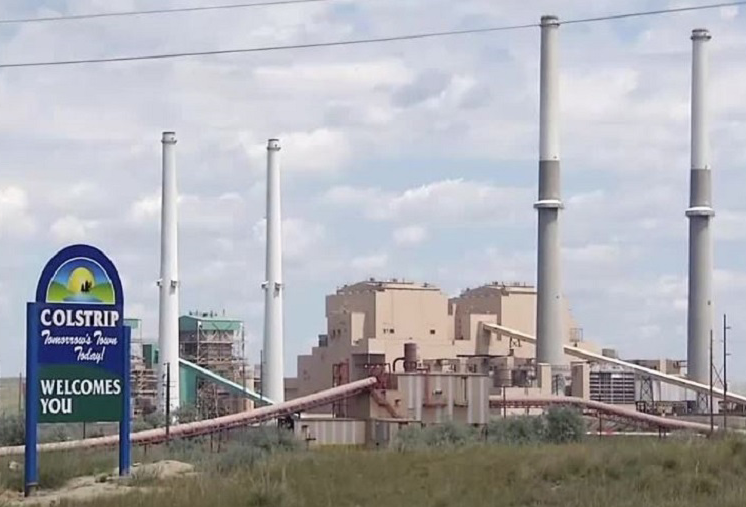Company Offers Possible Solution for Colstrip Waste, New Opportunities
Could it be that a new technology that utilizes a waste material of Colstrip power plants — coal ash— can build the foundation (perhaps quite literally) of a new economy for Colstrip?
David White, CEO and co-founder of RamRock Building Systems, LLC, of Chattanooga, Tennessee, believes so and he has come to Montana to try to persuade Talen Energy, Montana regulators, and the public to take his company’s proposal seriously.
The product can be a low-cost strengthening additive to Portland cement, as well a high-quality, low-cost alternative to conventional concrete. Because the product locks up toxins in the ash at the molecular level, it becomes environmentally benign. It’s a win, win on every front.
“It effectively turns waste into wealth to the lasting economic and environmental benefit of the people of Montana and beyond,” said White. “This is a break through. It is break through chemistry…something that did not exist before…. we are doing something no one else is doing…. we can revolutionize the nation’s electric utility industry.”
RamRock first tested similar material in the US two and a half years ago, having initially been developed and commercialized by RamRock’s overseas technology partner ARC Innovations in South Africa.
White’s biggest problem seems to be that it sounds too good to be true, but since RamRock is simply importing proven technology for domestic commercialization, all they really need to do is to demonstrate how it can benefit a trillion-dollar disposal problem in the US.
White has presented his proposal to Talen Energy, a partial owner, and the operator of Colstrip generators 3 and 4, which may otherwise close within the next five years. Talen Energy is responsible for determining how they will mitigate the environmental threat of the residual coal ash of which there are, according to DEQ, some 15 million tons, not counting perhaps 20 million more tons from the older, now-defunct units, Colstrip generators 1 and 2.
Disposing of those wastes onsite will cost between $400 million and $700 million for units 3 and 4 alone, and several times that if it is determined that that waste and the waste from units 1 and 2, must be removed for burial in lined landfills.
The closed J. E. Corette Power Plant in Billings is also a likely beneficiary of White’s new technology. The plant was where two local political candidates made a public announcement a couple weeks ago, heralding the product’s potential benefits.
Public Service Commissioner Tony O’Donnell and state Rep. Rodney Garcia, both of whom are in re-election campaigns, held a press conference trying to gin up public support for the idea and for their campaigns.
O’Donnell said it is not only an opportunity to clean up a toxic waste site but a public relations coup for Talen Energy in being able to claim credit and help generate sorely needed jobs for the Colstrip area.
For RamRock the press conference was an opportunity to generate public support.
White first contacted Rep. Garcia during the state legislative session when Garcia was trying to convince legislators that the state should buy the Colstrip Power Plant. Press coverage made White aware of Garcia and of the problems confronting Montana in the possibility of losing jobs and the economic base that comes from energy generation at Colstrip.
DEQ must approve the idea for Talen Energy to act upon it, since DEQ has oversight on how the ash is disposed of.
White has been in conversations with DEQ officials since a visit to Montana with ARC Innovations last July. His company is presently preparing the documentation for a Beneficial Use Determination (BUD) by DEQ before the month is out. Meanwhile, RamRock remains in discussions with Talen Energy regarding a demonstration project that White hopes will “carry the day” for his company’s “cutting-edge, economic development initiative.”
White makes clear that the product needs no research and development funding, as the proposed demonstration is just that — preliminary testing on Colstrip ash to demonstrate that it has compression strength in excess of 6,200 PSI in a mere 7 days.
At that strength the product is well beyond that needed for conventional concrete, said White. And, it is perfect for the all-concrete home and related construction that RamRock is pioneering in association with ARC Innovations.
A demonstration video shows the product being made simply and quickly using nothing more than a bowl and a stick —- mixing the coal ash with a couple of proprietary liquids and pouring the fluid into a plastic container. In about 29 minutes, sitting at room temperature, the fluid is no longer fluid and in an hour and a half it can be removed from its mold and is “as hard as a rock” – and maybe more so.
RamRock’s Colstrip initiative is based on a preliminary proposal submitted to the US Department of Energy last year for a “Zero emissions approach to all solids, liquids, and gases, including CO2” and its use, among other things, in feeding an onsite indoor farming complex which would provide “year-round, 24/7, fresh, organic, fruits and vegetable.”
“We have the technology,” says White, “and repurposing the money that will otherwise be spent to either cover Colstrip’s coal ash problem up or move it elsewhere is all that really stands between embracing the future and turning our back on it.”


0 comments